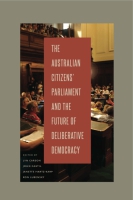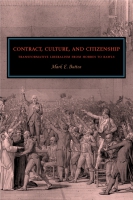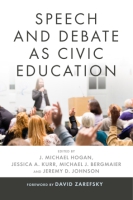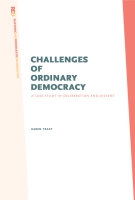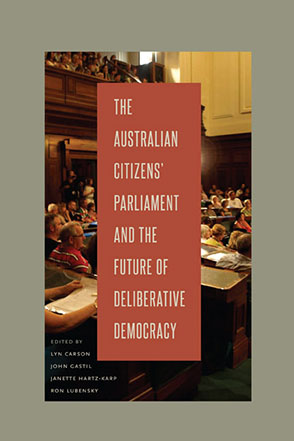
The Australian Citizens’ Parliament and the Future of Deliberative Democracy
Edited by Lyn Carson, John Gastil, Janette Hartz-Karp, and Ron Lubensky
The Australian Citizens’ Parliament and the Future of Deliberative Democracy
Edited by Lyn Carson, John Gastil, Janette Hartz-Karp, and Ron Lubensky
“As innovators in democratic process, we know how much we depend on learning from practical trials and real-world experiences. This work captures the experience in detail and provides an important reference point for anyone hoping to bring deliberation and the citizen’s voice back into how we do government.”
- Description
- Reviews
- Bio
- Table of Contents
- Sample Chapters
- Subjects
The ACP’s Canberra assembly is the first large-scale, face-to-face deliberative project to be completely audio-recorded and transcribed, enabling an unprecedented level of qualitative and quantitative assessment of participants’ actual spoken discourse. Each chapter reports on different research questions for different purposes to benefit different audiences. Combined, they exhibit how diverse modes of research focused on a single event can enhance both theoretical and practical knowledge about deliberative democracy.
“As innovators in democratic process, we know how much we depend on learning from practical trials and real-world experiences. This work captures the experience in detail and provides an important reference point for anyone hoping to bring deliberation and the citizen’s voice back into how we do government.”
“This study shows that deliberative capacity, personal efficacy, and common political ground can be developed through the careful design of deliberative institutions among ordinary citizens; even so, meaningful political influence over a broader social scale remains as elusive as ever. The editors present valuable and hard-won lessons for citizens, leaders, and academics who hope to realize the practical political and moral benefits of a more truly deliberative and democratic public life. The Australian Citizens’ Parliament and the Future of Deliberative Democracy is full of practical wisdom for anyone who sets out to create a democratic deliberative space for ordinary citizens.”
“From conception to conclusion, this book narrates and analyzes an ambitious experiment in deliberative democracy: the Australian Citizens’ Parliament. Integrating social science analyses of many kinds of data with reflections by philosophers and civic reform–minded public participation practitioners, the volume offers a rich sense of what occurred in the different phases of the ACP process and provides a nuanced assessment of the strengths and weaknesses of this large-scale deliberative democracy experiment. This wonderful case study is a must-read for everyone interested in deliberative democracy.”
Lyn Carson is Professor in the Business Programs Unit at the University of Sydney Business School and a co-initiator of the Australian Citizens’ Parliament.
John Gastil is Professor and Head of Communication Arts and Sciences at The Pennsylvania State University.
Janette Hartz-Karp is Professor of Sustainability at Curtin University’s Sustainability Policy Institute.
Ron Lubensky is a doctoral candidate at the School of Humanities and Communication Arts, University of Western Sydney.
Contents
List of Illustrations
List of Tables
Acknowledgments
Introduction
Lyn Carson, John Gastil, Janette Hartz-Karp, and Ron Lubensky
Part I: Deliberative Design and Innovation
1 Origins of the First Citizens’ Parliament
Lyn Carson and Luca Belgiorno-Nettis
2 Putting Citizens in Charge: Comparing the Australian Citizens’ Parliament and the Australia 2020 Summit
Janette Hartz-Karp and Lyn Carson
3 Choose Me: The Challenges of National Random Selection
Ron Lubensky and Lyn Carson
4 Grafting an Online Parliament onto a Face-to-Face Process
Brian Sullivan and Janette Hartz-Karp
Part II: Exploring Deliberation
5 Listening Carefully to the Citizens’ Parliament: A Narrative Account
Ron Lubensky
6 Deliberative Design and Storytelling in the Australian Citizens’ Parliament
Laura W. Black and Ron Lubensky
7 What Counts as Deliberation? Comparing Participant and Observer Ratings
John Gastil
8 Hearing All Sides? Soliciting and Managing Different Viewpoints in Deliberation
Anna Wiederhold and John Gastil
9 Sit Down and Speak Up: Stability and Change in Group Participation
Joseph A. Bonito, Renee A. Meyers, John Gastil, and Jennifer Ervin
Part III: The Flow of Beliefs and Ideas
10 Changing Orientations Toward Australian Democracy
Simon Niemeyer, Luisa Batalha, and John S. Dryzek
11 Staying Focused: Tracing the Flow of Ideas from the Online Parliament to Canberra
John Gastil and John Wilkerson
12 Evidence of Peer Influence in the Citizens’ Parliament
Luc Tucker and John Gastil
Part IV: Facilitation and Organizer Effects
13 The Unsung Heroes of a Deliberative Process: Reflections on the Role of Facilitators at the Citizens’ Parliament
Max Hardy and Kath Fisher, with Janette Hartz-Karp
14 Are They Doing What They Are Supposed to Do? Assessing the Facilitating Process of the Australian Citizens’ Parliament
Li Li, Fletcher Ziwoya, Laura W. Black, and Janette Hartz-Karp
15 Supporting the Citizen Parliamentarians: Mobilizing Perspectives and Informing Discussion
Ian Marsh and Lyn Carson
16 Investigation of (and Introspection on) Organizer Bias
Lyn Carson
Part V: Impacts and Reflections
17 Participant Accounts of Political Transformation
Katie Knobloch and John Gastil
18 Becoming Australian: Forging a National Identity
Janette Hartz-Karp, Patrick Anderson, John Gastil, and Andrea Felicetti
19 Mediated Meta-deliberation: Making Sense of the Australian Citizens’ Parliament
Eike Mark Rinke, Katie Knobloch, John Gastil, and Lyn Carson
20 How Not to Introduce Deliberative Democracy: The 2010 Citizens’ Assembly on Climate Change Proposal
Lyn Carson
Conclusion: Theoretical and Practical Implications of the Citizens’ Parliament Experience
Janette Hartz-Karp, Lyn Carson, John Gastil, and Ron Lubensky
Index
Introduction
Lyn Carson, John Gastil, Janette Hartz-Karp, and Ron Lubensky
Democracy remains the aspiration held by governments the world over. Newly minted nations typically build popular sovereignty into their constitutions, and those nations with long-standing traditions of self-governance continue to amend their own distinct methods of assembling, informing, and aggregating their many publics.
At the same time, many critics have decried the emergence of a “democratic deficit,” wherein representative government resists more direct forms of public involvement. Though representative institutions have endured for decades or even centuries in some countries, they have tended to concentrate power, particularly in those groups with particular vested interests. Citizens have been relegated to voters, responsible only for choosing decision makers, whom voters may hold accountable if a sufficiently strong opposition can form.
Fortunately, with dozens of nations and thousands of municipalities experimenting with democratic reforms, there exist many opportunities to glimpse the brightest possible future for democracy. One such vision comes from Australia, a country with a proud history of political innovation. Australia led the world in the use of the secret ballot, which was known simply as the “Australian ballot” for many years. It also led the way in developing preferential voting, and women gained the vote in Australia long before women’s suffrage arrived in the United States and other countries. In the twenty-first century, Australia has helped lead a global movement toward a deliberative form of democracy.
The Deliberative-Democratic Vision
As defined by scholars and refined by civic reformers, deliberative democracy is a theory of a different form of democracy. In simple terms, this conception of self-government emphasizes the need for informed, reflective, and inclusive public discussion, debate, and dialogue, with the judgments yielded from such exchanges holding sway over public policy in particular, but broader public opinion as well.
This vision shares the participatory-democratic commitment to inclusion and civic engagement and the direct-democratic demand for empowered citizens, but it balances this with representative democracy’s aspiration for the sober judgment that comes most readily when a body forms to study and weigh the complexities of public issues. Though championed, at times, as an alternative to adversarial representative government, more often the deliberative turn shows the way to a more robust adaptation of existing government practices. Whatever its inflection, deliberative-democratic reform is a normative project premised on the belief that developing a deeply considered public judgment among a diverse group of citizens can strengthen government decision making, as well as creating a more politically efficacious citizenry.
For some it is an ideal towards which we might aspire, for others it can be and is enacted every day. It is more a preoccupation (in philosophical thought and practice) of developed rather than developing countries, though there is evidence of deliberative democracy being practiced in some unlikely locations. Deliberative democracy can be seen as both a theoretical framework within which the practice resides as well as an umbrella term which includes processes such as citizens’ juries, consensus conferences, planning cells, deliberative opinion polls, and large-scale citizens’ assemblies and town meetings.
How this deliberative intellectual and civic-reform movement will reshape the nation-state remains to be seen. In particular, researchers and reformers face the challenge of designing an inclusive process that meets a high standard for deliberation and yields meaningful long-term changes in the participants, the government, or even the wider society.
It is the contention of the editors of this volume that we can only understand the likely trajectory of deliberative reform if we first take stock of the work already undertaken in its name. Thus, we turn to Australia—that curious incubator of new democratic procedures—and focus on its grandest and most recent creation, a special parliament of citizens.
The Design of the Australian Citizens’ Parliament
In grasping the design of the ACP, it is important to understand that the four-day assembly in Canberra constituted the pinnacle of the process, but important preliminary events preceded that. Figure I.1 gives a complete overview of the ACP process, its research components, and how they dovetailed with contemporary events in Australia.
The Australian Citizens’ Parliament (ACP) deliberative assembly took place in Old Parliament House in Canberra on February 6–9, 2009. This forum was the final event of a deliberative process that began years before (see chapter 2) with a series of public World Cafés which determined the question to be answered by the ACP, often referred to as a “charge” as for trial jury deliberation. The ACP began in earnest in October 2008 and involved introductory regional meetings, online deliberations, and a four-day face-to-face event by 150 randomly selected “Citizen Parliamentarians” (CPs). The ACP addressed the question “How can the Australian political system be strengthened to serve us better?” The CPs ultimately made a series of prioritized recommendations that were included in the ACP’s final document and delivered to the Australian prime minister and members of Parliament.
Unlike many deliberative forums, the ACP was not a “top-down” affair convened by decision makers and drawing citizens into “invited spaces” to solicit their counsel. Rather, a key organizer behind the ACP was the newDemocracy Foundation, a non-government organization whose raison d’être is to instigate the search for alternatives to the current system. Though the ACP’s recommendations ultimately were handed over to government, the latter was not the host. This is an example of an “insisted space,” in which citizens self-organize or are facilitated by civil society (including universities) to influence the government.
The ACP structure and design aimed to maximize “representativeness,” “deliberativeness,” and “influence.” Randomness and influence are described in the chapters that follow; however, the story of how deliberation was generated needs more elaboration.
The structure of the ACP included the daily random seating of CPs in small facilitated groups and the assistance of networked computers and theme team to collect and synthesize information from each table. Process design features included sharing the role of lead facilitator to reflect a separate focus on dialogue and deliberation, the selection of facilitators, prior training and information, and daily debriefs. The agenda design was the deliberation engine room. Known and innovative deliberative techniques were integrated, each building on the prior and preparing the ground for the next, often with adaptations or innovations to push the boundaries of usual practice. The following description highlights why various techniques were used and where they fit into the overall story of the ACP. The detailed agendas are also available.
The ACP began with a series of regional meetings, which focused on welcoming, informing, building confidence skills, and teamwork. Techniques used to achieve this included speed introductions, World Café, brainstorming, and an adaptation of Open Space. In effect, these meetings were a highly unusual opportunity for citizen deliberators to help frame their question and shape the process they would later use to examine it. The Online Parliament deliberation that followed was an innovative platform pioneering self-managed, deliberative teams. It aimed to spark deliberation using a different mode and to produce proposals that could frame the initial agenda of the face-to-face assembly in Canberra.
Given the breadth of the ACP charge, it was a challenge to reach an outcome from the four-day ACP that all involved would deem satisfactory, rather than dismissing it as “yet another talkfest.” The technique connecting the different pieces of the agenda puzzle, helping to produce a coherent outcome acceptable to participants, was a 21st Century Dialogue system. The networked computers enabled the inputs from the small-group deliberation to be rapidly themed, prioritized, and displayed to the whole group, culminating in daily preliminary reports and the final report.
Each day, the ACP agenda was bookended with a welcome/icebreaker and a closing activity at the end. This was interspersed with plenary sessions, usually in the formal House of Representatives chamber, and small-group deliberation, usually in the parliamentary dining room. CPs were asked (though not compelled) to fill out a reflections card daily. When they had left the parliament, each of the support teams conducted its own briefing session. Social events in the evenings encouraged informal discourse and fraternity.
The stated aim of Day 1 of the ACP was “Understanding what we want to achieve together at the ACP.” It began with traditional pomp and ceremony to welcome CPs, attending members of Parliament, the support team, and others, with the representatives of the top five prioritized online deliberation teams then formally presenting their proposals. The remaining agenda focused on improving CPs’ understanding of dialogue and deliberation and how they would work together. This began with small group dialogue to visualize what success might look like and how this deliberation might be different, followed by deliberation using the 21st Century Dialogue system to comment on, add to, and amend the online proposals.
The aim of Day 2 was “Broadening our perspectives.” This included both content issues and understanding of dialogue and deliberation. Throughout the day, new proposals and ideas for them were generated. Techniques used included a World Café using Appreciative Inquiry to explore the positive aspects of our political system; deliberation to develop table questions and ideas for expert panelists representing different viewpoints on the pros and cons of existing and new proposals; a reflective conversation, with “experts’ being interviewed; and an Open Space so CPs could delve into the particular issues they wanted to pursue.
The Day 3 aim was “Determining what is most important to us.” This was a pivotal day, when the large number of generated proposals (fifty-two) needed to be understood and potentially challenged and the criteria for assessing them determined and weighted, and then preferenced accordingly using a prioritization facility in the 21st Century Dialogue system. The day began with a focus on further understanding the proposals, amending them, and adding new proposals, with expert panelists commenting and responding to questions. Next, small groups deliberated the characteristics of a healthy political system that would reflect the legacy they would like to leave to future generations. Using the prioritization facility, the CPs determined the top five characteristics and then honed down the list of proposals to the top thirteen. To promote further reflection and critique a Fishbowl technique was applied, whereby nominated CPs deliberated on stage about proposals they favored in light of the dominant characteristic. Then using the same prioritization facility the thirteen proposals were assessed by all CPs against each of the top five characteristics. Final prioritizations included which proposals were the easiest to implement, the most innovative, and the most important in the long term. The day concluded with CPs being nominated to present the ACP findings to the assembly and the Government representative in attendance on the final day.
The aim of Day 4 was “Consolidating and delivering our recommendations.” A draft of the final report was distributed to CPs for their consideration and amendment. Following this there was a dialogue on the lowlights, highlights, and insights of the ACP. In parallel, the nominated CP presenters prepared what they would say, with some coaching and a practice session to the ACP plenary. After their formal presentation in the House of Representatives, and the Government response, the ACP concluded with small-group dialogue (about next steps, impacts, and learning), followed by lighthearted performances by CPs reflecting their experiences and then the viewing of a final short video of ACP highlights.
A Plurality of Research Methods
A primary reason this book exists is that its organizers always conceived it as both a public-engagement process and a research exercise—one that ultimately secured funding from both the Australian Research Council and the U.S. National Science Foundation. Completing a stream of surveys and having their every word recorded, the CPs themselves became acutely aware of the project’s dual mission, and, at one point during the Canberra assembly, they collectively demanded that the researchers better explain themselves and their purposes. It was through the patience and commitment of the CPs that the ACP became an ideal site for detailed scholarly examination.
Above all else, the ACP’s Canberra assembly was the first large-scale, face-to-face deliberative project to be completely audio-recorded and transcribed. This makes possible an unprecedented level of qualitative and quantitative assessment of the actual spoken discourse of the participants. These transcripts are coupled with comprehensive participant-survey data and electronic records of the 21st Century Dialogue system. This amounts to hundreds of data points that can be organized around each person, group, or activity.
How should research about a large-scale deliberative process be conducted? The contributors to this volume work in a range of disciplines both inside and outside of academia. Each reports on different research questions for different purposes to benefit different audiences. Most methodologists would identify three broad modes of research in this volume, which can be distinguished as social-scientific, interpretive, and critical modes of inquiry.
The social-scientific mode includes studies that attempt to make claims about how and why aspects of deliberative processes really occur. The studies might identify categories that would apply to more cases besides the ACP, and even provide evidence for theories that can predict the activity and outcomes of similar deliberative processes in the future. These studies are usually organized scientifically, with hypotheses which lead to an unambiguous assessment of the truth of them through rigorous methods. Some studies invert that approach, generating theory that is grounded in observation and logical analysis. Unfortunately, for research about human activity rather than the natural world, the findings are rarely unequivocal, so statistical methods are often used to uncover probabilities, trends, and clustering. Usually, the researcher seeks to remain objective and detached from the subjects of the study.
In the interpretive mode of studies, the main aim is to gain an understanding of the activity and its aspects through interpretive analytic methods. In some of these studies the researcher, as with the social-scientific studies, takes an authoritative stance, which may involve direct contact with participants through nonparticipant observation or structured interview, or persuasive deductive analysis on secondary sources. In other studies the researcher takes a more reflexive stance with participants to investigate subjectivity and particularity and is more tolerant to multiple interpretations and understandings. These latter “postmodern” studies often explore the range of meanings and experiences of participants from their perspectives and relate these using social, cultural, and other frameworks by well-respected scholars. In this volume we also include pragmatic practitioner reporting in the interpretive mode.
Finally, the critical mode of studies can draw methods from either of the first two, but is differentiated by a critical researcher stance that not only takes sides with the participants, but may actively advocate for change and improvement in the situation under study. Often the researcher is a practitioner who becomes the central participant in the study. At the heart of most of these studies is an effort to bring taken-for-granted aspects of the study context into focus, especially when those aspects are found to hinder progress towards an idealized situation.
The authors of this volume have traversed broadly across this research landscape. Some chapters are firmly positioned in a particular approach, whereas others develop lines of argument using multiple modes. To help appreciate these differences, we note the predominant modes as we introduce each of the chapters.
Organization of the Book
To study this unique process, we took what may be an equally novel editorial approach. We began with our team of four editors, each of whom was intensively involved in the creation, design, implementation, and/or study of the ACP. For Lyn Carson and Janette Hartz-Karp, the ACP represented a continuation of a multiyear collaboration in which they have experimented with combining different methods of deliberation and dialogue in Australia. Ron Lubensky has devoted his postgraduate career to understanding and advancing the practice of public deliberation, and he helped design many key features of the ACP, as well as its online components. Though John Gastil attended the ACP, he did so as a researcher rather than a designer or organizer, and he brings to this project two decades of experience studying and writing on deliberative processes large and small.
Rather than playing a relatively passive editorial role, however, we took on authorial roles in nearly all of the chapters in this book. This gave the book a stronger narrative continuity and ensured that every chapter drew not only on outside knowledge but also on the direct experience of event organizers and researchers. That said, we released the ACP data into the wider scholarly community and successfully solicited a large team of chapter authors from coast to coast in Australia and the United States, plus investigators from Germany, Italy, Switzerland, and the United Kingdom.
The chapters of this book are organized into five parts, each prefaced by a brief introduction to the chapters that are included. Part I provides detail about the inception and design of the ACP, providing context for the rest of the book and informing discussion about large-scale process improvement. Through a range of study approaches, part II contains chapters that explore the nature of the deliberation by ACP participants. The authors in part III present their analyses of the content of the ACP deliberations to show how beliefs and ideas shifted and flowed during the process. Part IV presents several chapters about facilitation and the organizers’ effects on participants. The chapters in part V reflect on the exercise and take a wider look at its impacts.
We cannot say whether, after reading this book, one will come away more sanguine or more glum about the prospects for deliberative democracy. All the authors herein share what might be called a cautious optimism. We have seen in the ACP great potential for robust and influential deliberation, but we have also glimpsed some of the same pathologies that plague contemporary politics and government. It is our greatest hope that by sharing our diverse perspectives, we will have enriched the reader’s own understanding of the potential and limitations of deliberative-democratic reform.
Mailing List
Subscribe to our mailing list and be notified about new titles, journals and catalogs.
